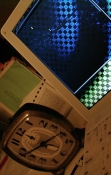February 2005
O Blessed Package
Monday, 28 Feb 2005 :-: ["Permalink"]
[soundtrack]
It took them a week to fix the laptop, though it took me several weeks to initiate the process. Few things equal the rush of pure joy I experienced when I saw the yellow DHL truck pulling into the driveway. I was listening to Ravel's Bolero, and it fit perfectly.
(the soundtrack for the day is a newagey remix of Bolero. I couldn't easily find a recording of the original online.)
** * **
I am grateful for my equipment failures. They always teach me something about my relationship to the tools I use. This time, while it was bad for my wrists, was very fruitful as a struggle of the mind. I learned how to use hypertext writing methods on paper.
More on this later. I have so much to say, so much to write about. The pent up thoughts of a month's silence are ready to burst. But I must hold it in for the moment; homework awaits.
illogic boards
Monday, 7 Feb 2005 :-: ["Permalink"]
This may be the last time I post for the next few days. My iBook has been having issues. After using it for a few minutes, it will blink and lock. I will not be able to SSH in remotely. Reboot, rinse, wash, repeat.
I believe it is the logic board. This is the third failure. I'm going to talk with the folks over in Cupertino and see what I can have done to prevent this from happening again. Fortunately, I know that I can trust them. Last time I had a problem, I called them at 6pm. The replacement part was at my door before I woke up the next morning. Apple is awesome about h/w repairs.
Etown Scouts
Monday, 7 Feb 2005 :-: ["Permalink"]
On Saturday, I was part of the Elizabethtown College Scouting University, an initiative to bring girl and boy scouts to the college to give them hands-on training in a number of badge requirements. We had around 380 kids.
I taught computers for 7 hours that day. It was exhausting. But it was exciting. The more I teach, the more fun I have doing it.
The girls wrote stories with a word processor, learned about ergonomics, edited digital photos, and put together a blog. You can read it at etownscout.blogspot.com.
16th and 17th century clothing
Thursday, 3 Feb 2005 :-: ["Permalink"]
For my class in 17th century metaphysical poetry, I was asked to find information on the clothing described in a poem by John Donne. I thought you might enjoy reading this as well.
** * **
For Elizabethan courtly outfits, check out "Putting on an Elizabethan Outfit," a great resource site on 16th century clothing. In fact, you might enjoy looking at the gallery of 16th century woman's clothing on the website. For an expemplary portrait of the typical Tudor (as descrbed in the first link), you may want to look at this Portrait of Lady Jane Dudley.
In Elizabethan times, the makeup was toxic. They actually put lead and vinegar on their faces to make them whiter! In fact, you will find an interesting resemblance between our modern concept of a clown and the makeup of Elizabethan women. Perhaps this is because clowns originated during this period -- they may have originally worn a parody of courtly dress.
They did have Corsets even though one is not mentioned in the poem.
But we're in the early 17th century, looking not at a Tudor queen, but at a Stuart King, James I. Elizabethan wear was probably a bit out of fashion by the time Donne wrote this poem in the early 17th century.
For an overview of the cultural, political, and religious influences on the clothing of all classes in 17th century England, read about Late 16th and Early 17th century garb for the Middle & Lower classes.
Much of the information we have on women's clothing in the 17th century comes from the etchings of Wenceslaus Hollar. Notice how the drawings of Wenceslaus Hollar show a considerably different image of women than do the Elizabethan pictures. Women had to wear much less. (Also, notice the second image on the previous page -- girls were wearing words on the front of their shirts back then too -- but the second image is from Belgium, not England.). A page on about.com shows the engravings Hollar made that depict 17th century English clothing styles.
It wasn't all simplicity, however. In another gallery on 17th century fashion, we see the broad range of styles, from "Lady with a Hat" to Mary RadCliffe to Woman with a Lute. All of this depended on what part of society the woman was. In fact, it should be possible to determine the socioeconomic status of "his mistress" by her clothing. During the reign of Henry VIII, sumptuary laws forced people to wear certain clothing so Henry could tell their class from outward appearance. But even by the 17th century, as in today, social status was still a big part of dress.
The pieces of clothing
Here's my best stab at what's going on. Let us use as an example the woman shown in this image from the spring fasion of 1654. This woman probably doesn't wear what the poem calls a breastplate. The "breastplate" reminds me of the partlet shown on the 16th century clothing page. The thing with the laces is probably this woman's buske, which *was* a sort of decorative, outerwear corset, which did have whalebone and possibly iron to shape a desirable figure. Note how fashion changes. In the 16th century, the gown is on the outside of the corset. But in the mid-17th century, the corset-like thing is on the outside of the gown. The woman in this picture has a bumroll on, although not the one in the poem. The gowns, are, well, the gowns. Notice how the woman in this picture shows her natural hair, tied to some sort of hair band. This was not always the case. People of nobility in particular would wear coronets. You can see a replica of a baron's coronet a halfway down this page of reproductions.
Notice how the shoes come after the gown. A woman would not be able to take off her shoes while in one of these costumes, partly for fear of making the material dirty (they wore capes to keep the grease from their infrequently-washed hair from harming the delicate fabrics), and partly because she might not have been able to bend down until her buske and gown were off. Putting on and taking off clothes must have been a horribly time-consuming task. Some examples of mid and late 17th century shoes can be found on the Northampton Museum's shoe collection page. Back then, shoes were often hidden underneath the gown.
Heels became important during Elizabeth's reign, though it was certainly not to highlight the legs. Notice how one set of woman's shoes on the museum site is intricately embroidered. About the only time I can imagine ornamentation being is important is *ahem* when the gown is taken off in the presence of another. Other shoe images, from all around Europe, can be seen on the website of La Couturiére Parisienne , in the gallery entitled "Hidden Fashion: The Shoe Special".
The final piece of clothing is the smock, which looks remarkably like the kind of costume used to depict angels in a play.
iBooking
Thursday, 3 Feb 2005 :-: ["Permalink"]
 It took longer than I expected.
It took longer than I expected.
I started to back up my laptop on Friday, plugging a friend's ibook into a usb hard drive, plugging my laptop into his, then schlepping the data over and tarring it up. Finally, around midnight, I started to reload OS/X. My partition map looks something like this:
- Bootstrap partition
- OS/X
- Linux Swap
- GNU/Linux
- Shared Data
Now that there's a stable HFS+ read/write driver for the Linux kernel, I will be able to store all my data on a single partition, ensuring that I have access to it from both operating systems. Furthermore, I plan on installing Mac On Linux once again, which will enable me to run applications like Tinderbox from within Linux. Before, the dual booting was a barrier -- it forced me to use OS X more than I would probably have preferred. Now, I can have the best of all possible worlds.
** * **
Unfortunately, StuffIt seems to be a little skittish with my tar files, which are several GB apiece. So I'm not quite up and running yet.
** * **
I delayed this project for a while, because I knew that it could take a lot of time. I hoped to do it over Christmas break, but alas, there was no time.
At least, OS/X is up and running, and I can blog once again.



 It took longer than I expected.
It took longer than I expected.